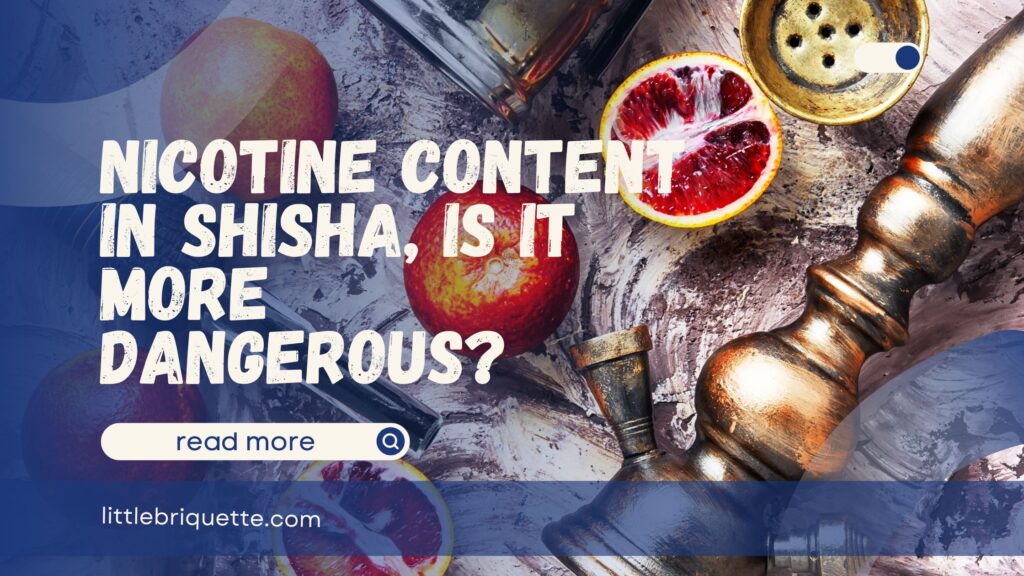Shisha is currently popular among people due to its innovative approach to smoking with various flavors and aromas. Although many believe that shisha is not more dangerous than regular cigarettes, it does contain nicotine. What are the nicotine content in shisha, and is it more dangerous compared to regular cigarettes? This will be discussed further below.
Nicotine Content in Shisha
Nicotine is an addictive substance naturally found in tobacco leaves. In shisha, the nicotine comes from the tobacco used, and the amount of nicotine in this mixture can vary. The addition of glycerin and molasses does not alter the nicotine content but helps to soften the smoke and enhance the smoking experience.
Several factors affect the actual nicotine content consumed from shisha:
Smoking Technique

The method of smoking shisha significantly impacts the amount of nicotine inhaled, with the intensity and depth of inhalation being key factors. Smoking shisha with high intensity, such as smoking for longer durations and more frequently, and inhaling the smoke more deeply, can increase the amount of nicotine entering the body. When shisha smoke is inhaled more deeply and for a longer time, more nicotine is absorbed through the lung linings and oral tissues, resulting in greater nicotine exposure compared to lighter or less deep smoking.
Type of Tobacco Used

The type of tobacco used in shisha affects the amount of nicotine consumed, as different types of tobacco have varying nicotine levels. High-nicotine shisha tobacco will release more nicotine during each smoking session compared to tobacco with lower nicotine content. Therefore, high-nicotine shisha tobacco can deliver a larger dose of nicotine, increasing health risks for users compared to tobacco with lower nicotine levels.
Intensity of Use

The intensity of shisha use, including the duration and frequency of smoking sessions, has a significant impact on total nicotine consumption. The longer and more frequently shisha is used, the more nicotine accumulates in the body. Longer shisha sessions allow for more nicotine to be inhaled and absorbed, while frequent use increases total nicotine exposure over time. In other words, intense shisha use can lead to higher nicotine accumulation compared to less frequent or shorter sessions.
Shisha Equipment Setup

The setup of the shisha equipment plays a crucial role in affecting the amount of nicotine inhaled. How the shisha is prepared, including the placement of the charcoal, water quality in the bowl, and airflow, can impact nicotine consumption. Charcoal that is too hot or uneven can affect tobacco combustion, while poor water quality can reduce nicotine filtration efficiency. Additionally, suboptimal airflow can alter the intensity and volume of smoke inhaled, affecting the amount of nicotine absorbed by the user. All these factors contribute to variations in nicotine consumption during shisha sessions.
Read Also: Shisha Pipe, What Are They and How Do They Function?
Effects of Nicotine on Health
After smoking shisha, nicotine immediately affects the central nervous system by increasing heart rate and blood pressure, and providing a stimulant effect that makes users feel more alert and energetic. Nicotine can also cause temporary euphoria and increase anxiety or stress in the short term. Additionally, nicotine stimulates the release of dopamine in the brain, contributing to feelings of pleasure and dependence. These effects may be followed by symptoms such as dizziness, nausea, or headaches, especially if a high amount of nicotine is inhaled or if the user is not accustomed to the substance.
Long-term use of shisha carries significant health risks, particularly because high nicotine content can lead to addiction. Nicotine addiction can potentially result in health issues such as hypertension and heart disease. Continuous stimulation of the cardiovascular system by nicotine can cause damage to blood vessels and the heart. Furthermore, frequent shisha use can exacerbate the risk of lung cancer, chronic respiratory diseases, and other lung disorders, as not only nicotine but also other harmful substances in shisha smoke affect lung health and other organs over time.
Comparison of the Health Risks of Nicotine in Shisha vs. Cigarettes
Here is a comparison of the health risks associated with nicotine in shisha versus cigarettes that users should be aware of.
Composition of Shisha Smoke vs. Cigarette Smoke
Both shisha and cigarette smoke contain harmful substances, but their compositions differ. Shisha smoke often contains higher levels of carbon monoxide, tar, and heavy metals compared to cigarette smoke due to the charcoal used to heat the tobacco. Although shisha may not be smoked as frequently as cigarettes, a typical shisha session lasts longer, leading to a larger volume of smoke being inhaled. In contrast, cigarette smoke contains nicotine and various carcinogenic chemicals that are directly inhaled into the lungs, causing damaging health effects.
Specific Health Risks
Both shisha and cigarette use are associated with serious health risks. Cigarettes are well-known for causing lung cancer, heart disease, and chronic respiratory disorders such as bronchitis and emphysema. Although shisha is often considered a milder alternative, it also poses similar risks due to the carcinogenic substances and other harmful materials in its smoke. The risk of lung cancer and heart disease from shisha can be elevated due to the nicotine and harmful substances exposed during longer smoking sessions. Respiratory issues, such as infections and reduced lung function, are also significant concerns for both shisha and cigarette smokers.
Studies and Research
Research indicates that both shisha and cigarettes have significant health impacts, despite differences in exposure methods and intensity. Studies suggest that shisha use can be comparable to or even exceed the health risks of smoking cigarettes, especially due to the longer session times and larger volumes of smoke. Other research notes that shisha smokers may be exposed to higher levels of carbon monoxide and other harmful chemicals compared to cigarette smokers. Although data is still evolving, the consensus from various studies is that both practices are detrimental to health, and smoking shisha is not as safe as often assumed.
Read Also: What’s in Shisha Tobacco? A Deep Dive into Its Ingredients
Coconut Charcoal for Hookah Heating
Hookah involves various components in the smoking process, one of which is coconut charcoal. Coconut charcoal plays a crucial role in heating the hookah, as it provides a purer aroma and taste compared to other types of charcoal. However, it is important to ensure the quality of the coconut charcoal you use, as high-quality charcoal enhances the flavor and aroma for the shisha user.You can obtain high-quality coconut charcoal exclusively from Little Briquette. Contact our admin at this number to make bulk purchases.

